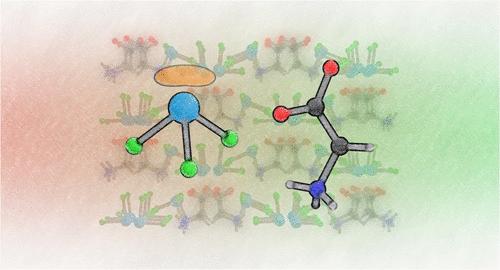Zwitterionic Glycine-Based Antimony Fluorides with Exceptional Ultraviolet Nonlinear Optical Properties
IF 7
2区 材料科学
Q2 CHEMISTRY, PHYSICAL
引用次数: 0
Abstract
Despite significant advancements in ultraviolet nonlinear optical (UV NLO) materials, a systematic design strategy remains elusive. This study introduces an approach to enhance NLO performance by utilizing zwitterionic units. Two antimony fluoride compounds, α–2SbF3·Gly and β–2SbF3·Gly, were synthesized by combining glycine zwitterions with Sb3+ cations and highly electronegative F– anions. The structure of α–2SbF3·Gly belongs to the polar noncentrosymmetric space group, Ia (No. 9), while β–2SbF3·Gly adopts the centrosymmetric space group, P21/c (No. 14). The metastable α–2SbF3·Gly undergoes an irreversible phase transition to the thermodynamically stable polymorph, β–2SbF3·Gly, at 160 °C. Notably, α–2SbF3·Gly exhibits an optimized arrangement of glycine zwitterions and SbF3 polyhedra, interconnected through hydrogen bonding. This structural configuration imparts exceptional optical properties, including a strong second-harmonic generation intensity 3.3 times that of KH2PO4, a wide band gap of 4.78 eV, and a suitable birefringence of 0.146 at 546 nm, highlighting its potential as an advanced UV NLO material. This work underscores the promise of zwitterionic units as a powerful design tool for UV NLO materials, providing a foundation for the development of next-generation NLO technologies.

具有特殊紫外非线性光学特性的双链甘氨酸基锑氟化物
尽管紫外非线性光学(UV NLO)材料取得了重大进展,但系统的设计策略仍然难以捉摸。本研究介绍了一种利用两性离子单元来提高NLO性能的方法。通过甘氨酸两性离子与Sb3+阳离子和高电负性的F -阴离子结合,合成了α-2SbF3·Gly和β-2SbF3·Gly两种氟化锑化合物。α-2SbF3·Gly的结构属于极性非中心对称空间群Ia (No. 9),而β-2SbF3·Gly则属于中心对称空间群P21/c (No. 14)。在160℃时,亚稳的α-2SbF3·Gly发生不可逆相变,转变为热力学稳定的多晶体β-2SbF3·Gly。值得注意的是,α-2SbF3·Gly表现出甘氨酸两性离子和SbF3多面体的优化排列,并通过氢键相互连接。这种结构赋予了其优异的光学性能,包括强二次谐波产生强度是KH2PO4的3.3倍,4.78 eV的宽带隙,以及在546 nm处0.146的合适双折射,突出了其作为先进UV NLO材料的潜力。这项工作强调了两性离子单元作为UV NLO材料强大的设计工具的前景,为下一代NLO技术的发展提供了基础。
本文章由计算机程序翻译,如有差异,请以英文原文为准。
求助全文
约1分钟内获得全文
求助全文
来源期刊

Chemistry of Materials
工程技术-材料科学:综合
CiteScore
14.10
自引率
5.80%
发文量
929
审稿时长
1.5 months
期刊介绍:
The journal Chemistry of Materials focuses on publishing original research at the intersection of materials science and chemistry. The studies published in the journal involve chemistry as a prominent component and explore topics such as the design, synthesis, characterization, processing, understanding, and application of functional or potentially functional materials. The journal covers various areas of interest, including inorganic and organic solid-state chemistry, nanomaterials, biomaterials, thin films and polymers, and composite/hybrid materials. The journal particularly seeks papers that highlight the creation or development of innovative materials with novel optical, electrical, magnetic, catalytic, or mechanical properties. It is essential that manuscripts on these topics have a primary focus on the chemistry of materials and represent a significant advancement compared to prior research. Before external reviews are sought, submitted manuscripts undergo a review process by a minimum of two editors to ensure their appropriateness for the journal and the presence of sufficient evidence of a significant advance that will be of broad interest to the materials chemistry community.
 求助内容:
求助内容: 应助结果提醒方式:
应助结果提醒方式:


